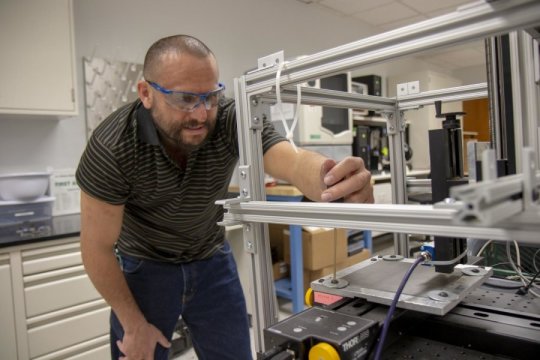[ad_1]
Researchers using magnetic signals have found unique “fingerprints” on steel, which could help to verify weapons treaties and reduce the use of counterfeit bolts in the construction industry.
“Magnetic signals provide a wide range of possible national security applications,” said David Mascareñas, a research and development engineer at Los Alamos National Laboratory and lead author of the study published recently in the journal Smart Materials and Structures. “It’s a promising phenomenon that we hope to leverage to uniquely identify different pieces of artillery.”
In the research, funded by the U.S Department of State, researchers applied Barkhausen noise, a magnetic phenomenon, to two types of steel — conventional steel and an abrasive-resistant type of steel used in mining equipment. A sensor measured electromagnetic signals by repeatedly scanning the different kinds of steel over a period of time. Researchers compared the signals from those two sets of scanned images and found signatures that were instrinsic to each type of steel.
The variations that occur from the production of various kinds of steel are reflected as distinct fingerprints. “They seem to be repeatable,” said Mascareñas.
That intrinsic signature could help to discover counterfeit or low-grade steel parts in construction by looking for differences in the electromagnetic signatures. “It could also help solve that big problem in that industry,” said Mascareñas.
Future research could involve studying other types of steel and developing a handheld sensor for treaty verification.
Publication: Barkhausen noise as an intrinsic fingerprint for ferromagnetic components, in Smart Materials and Structures. Authors: David Mascareñas, Michelle Lockhart, Thomas Lienert Funding: U.S Department of State — Key Verifications Assets Fund.
About Los Alamos National Laboratory Los Alamos National Laboratory, a multidisciplinary research institution engaged in strategic science on behalf of national security, is operated by Triad, a public service oriented, national security science organization equally owned by its three founding members: Battelle Memorial Institute (Battelle), the Texas A&M University System (TAMUS), and the Regents of the University of California (UC) for the Department of Energy’s National Nuclear Security Administration.
Los Alamos enhances national security by ensuring the safety and reliability of the U.S. nuclear stockpile, developing technologies to reduce threats from weapons of mass destruction, and solving problems related to energy, environment, infrastructure, health, and global security concerns.
Story Source:
Materials provided by DOE/Los Alamos National Laboratory. Note: Content may be edited for style and length.
[ad_2]















